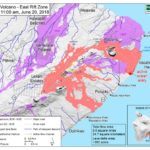The 7-week-old eruption on Kilauea’s lower East Rift Zone has reached a new milestone.
Steve Brantley, Hawaiian Volcano Observatory deputy scientist-in-charge, said during a community meeting Tuesday evening in Pahoa that preliminary estimates show it has produced about 145 million cubic meters of lava — more than the last two eruptions in the area.
“It’s a very difficult number to come up with,” he said. “But it gives you a ballpark that this current eruption is erupting lava at a higher rate than both of those eruptions.
“At this point, it doesn’t look like it’s slowing down whatsoever.”
Brantley said the 1960 eruption that destroyed the village of Kapoho erupted 122 million cubic meters of lava over 37 days, while the 1955 eruption produced 81 million cubic meters over 88 days.
The ongoing eruption started May 3 and is approaching its 50th day.
It has destroyed 577 homes, by official estimates.
The Federal Emergency Management Agency opened a Disaster Recovery Center last week at the Keaau High School.
Janet Snyder, spokeswoman for the Mayor’s Office, said Wednesday morning that more than 1,000 people have registered with FEMA. Despite rumors to the contrary, she said residents don’t need a letter from the county to register with FEMA for assistance.
The Disaster Recovery Center is open from 8 a.m.-8 p.m. seven days a week.
The U.S. Small Business Administration also provides aid to residents, homeowners and businesses through low-interest loans.
“It’s not a handout,” said Garth MacDonald, SBA public information officer. “This is your tax dollars at work.”
The state Board of Agriculture approved emergency low-interest loans for farmers who lost crops due to the volcano, in addition to flooding on Kauai. That allows loans up to $500,000 with 3 percent interest.
The state Department of Agriculture also offers micro-loans up to $25,000. The loan division can be contacted at 973-9460.
Roy Takemoto, executive assistant to the mayor, told those in attendance at the Tuesday meeting that the county might have a relocation or housing proposal ready in the next couple of weeks for those displaced. He said the “underlying principle” is to provide choice.
“Because we provide these choices, you will be able to select an option that works best for you, whether it be an existing vacant lot, a rental some place or even a lot in a new community — those are the types of housing solutions that we would be looking at,” he said.
Brantley said the perched lava channel from fissure 8 is 50 to 60 feet tall in some areas, and the fissure’s cone continues to grow slightly.
So far, the channel has remained fairly stable and overflows haven’t traveled far.
“The longer term concern if that channel or the levees on the channel fail is that it becomes an exit point for that lava,” he said.
Brantley said geologists are astounded by the changes at the summit of Kilauea, which continues to subside due to the withdraw of magma underneath.
He said the extent of the caldera collapse has now exceeded a similar event that occurred in 1924.
Brantley said the collapse has probably doubled the size of Halema‘uma‘u crater, which is now about 1,000 feet deep.
USGS estimates the volume of the collapse in Halema‘uma‘u to exceed 250 million cubic meters. That reflects what has fallen in and subsided, said Leslie Gordon, USGS spokeswoman, in an email.
“It is not a direct measurement of the magma that has drained from below the crater, but we think that this may approximate the amount of magma lost from the summit during this time,” she said.
Explosive events at the summit occur ever 20 to 24 hours, Brantley said.
East Hawaii might get relief from vog as the National Weather Service forecast calls for trade winds to return today, and they should remain through early next week.
Reporter John Burnett contributed to this report.
Email Tom Callis at tcallis@hawaiitribune-herald.com.







